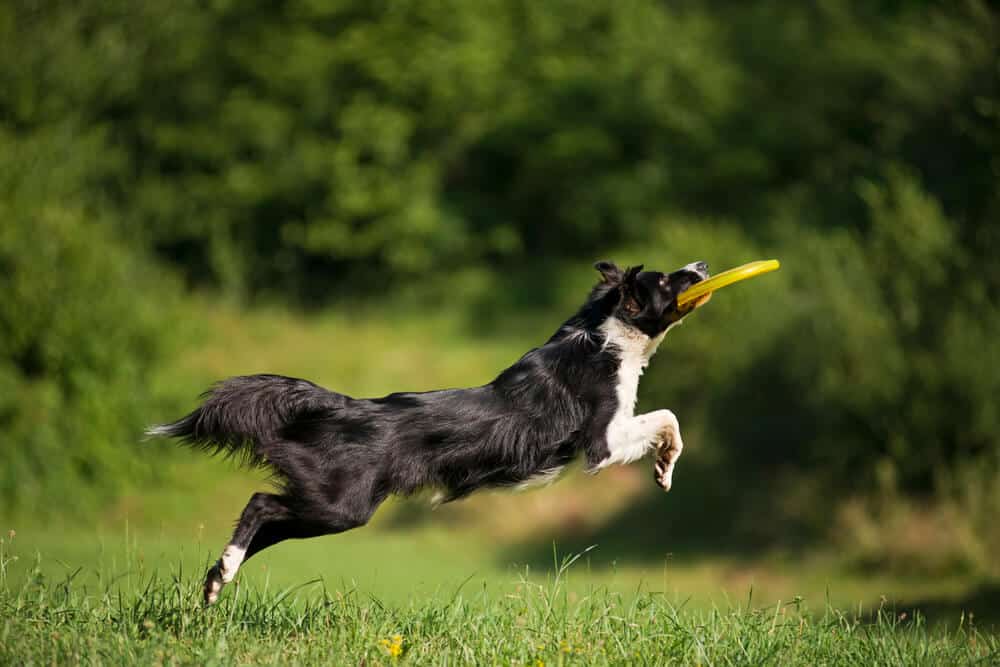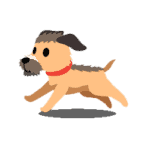Border Terriers are a small, agile, and energetic breed known for their unique wiry coat, fearless expression, and dynamic temperament. When considering the difference between male and female Border Terriers, it is essential to understand that while there may be general patterns exhibited by each sex, individual personalities and characteristics can also differ significantly.

The breed, originally from the United Kingdom, has been a popular choice among dog enthusiasts for decades, owing to their versatile nature and adaptability to various lifestyles and environments.
Male Border Terriers typically weigh between 13 and 15.5 pounds, whereas females usually weigh between 11.5 and 14 pounds.
Beyond these physical distinctions, dog owners and experts may share their experience on subtle differences in temperament and behavior between male and female terriers. Exploring these variations can help new and prospective owners in making an informed decision on choosing the right dog for their household while also setting realistic expectations for the nurturing and upbringing of their furry companion.
In the following sections, this article will delve deeper into the specific behavioral and temperamental differences between male and female Border Terriers, along with expert insights and experiences from owners. By understanding the nuances and particularities of each sex, it becomes simpler for individuals to select a pet that best aligns with their own lifestyle, preferences, and capabilities.
A well-matched relationship with a Border Terrier promises years of companionship, joy, and fulfillment for both the owner and the dog.
History of Border Terriers

The Border Terrier is a breed of dog that originated in the Cheviot Hills area along the border between Northern England and Scotland. Developed in the 18th century, this versatile working terrier was used by local farmers to hunt and control the fox population.
Its strong front quarters and agile body enabled it to easily pursue foxes into narrow spaces that other breeds couldn’t access.
Initially, the breed was known as the Coquetdale Terrier or Redesdale Terrier, named after the regions in which it evolved. By the late 1800s, it became widely recognized as the Border Terrier, largely due to its association with the Border Hunt in Northumberland.
As a working terrier, the Border Terrier played a crucial role in keeping the fox population under control. During hunts, these dogs were expected to keep up with foxhounds and drive foxes out of their hiding places or underground dens.
In addition to their prowess in hunting foxes, Border Terriers were also known to tackle larger animals, such as badgers and otters.
Despite their working roots, Border Terriers are now cherished as family pets and show dogs. The breed has maintained its distinctive characteristics and adaptability, making it popular among enthusiasts of terrier breeds.
In summary, the Border Terrier is a historically significant breed, born in the Cheviot Hills and closely tied to the farming communities of Northern England and Scotland. Its tenacity and skill in controlling fox populations earned it a valuable position in working terrier history, and today, this breed continues to serve both as a charming pet and a competitive show dog.
Physical Characteristics
Border Terriers are a small, agile dog breed that exhibits a few differences in physical characteristics between the males and females.
In terms of size, male Border Terriers typically have a height between 12-15 inches at the shoulder, while females stand slightly shorter at around 11-14 inches.

This size difference is common among dog breeds, with males generally being larger than females. The weight of a male Border Terrier falls between 13 to 15.5 pounds, whereas females weigh around 11.5 to 14 pounds. Although these differences are not drastic, it is important to note them when considering the physical characteristics of the breed as a whole.
Border Terriers possess a wiry coat that is weather-resistant and strong, providing them with protection while they engage in activities outdoors. The breed features a double coat, with a dense, soft undercoat and a coarse, protective outer coat. This coat type requires regular grooming and brushing to maintain its texture and overall appearance.
The breed comes in various colors, including blue and tan, red, grizzle and tan, and wheaten. Both male and female Border Terriers may be found in any of these color combinations, with no apparent differences in patterns or pigmentation between the two genders.
The body of a Border Terrier is well-proportioned, with a moderately broad chest and a level back. Their shoulders are well laid back, contributing to their fluid movement and overall agile nature. Males and females share these physical traits, although males may exhibit a slightly wider chest and more prominent muscle tone due to their larger size.
In conclusion, Border Terriers are a compact, sturdy breed, with both male and female individuals exhibiting some variation in size and weight.
Their wiry double coats and variety of coat colors allow for a diverse range of appearances within the breed, while their well-proportioned bodies and agile movement remain consistent across both genders.
Personality Traits
Border Terriers are known for their unique combination of personality traits that make them interesting and adaptable companions. These dogs possess a blend of both affectionate and independent qualities, which means they enjoy being around their family members but can also have a strong-willed side.
In terms of temperament, Border Terriers are generally happy and friendly dogs. They tend to be good around children and other pets when properly trained and socialized.
Given their background as working dogs, they also have a serious and determined side that contributes to their strong work ethic.
Loyalty is often associated with Border Terriers, as they form strong bonds with their owners. This makes them excellent watchdogs and trustworthy companions.
Alongside this, they are also intelligent dogs, which means that they can be easily trained when given the right guidance. However, it is essential to be patient and consistent in training, as their independent nature can sometimes make them appear stubborn during the process.
Male and female Border Terriers may exhibit slight differences in their personalities and temperaments. Typically, males might exhibit more confidence while females might exhibit more sensitivity or be calmer. However, both genders usually have the same core traits, making them equally versatile and enjoyable pets.
In summary, the personality traits of Border Terriers make for happy, loyal, and adaptable pets. Their affectionate nature combined with their independent streak and intelligence creates a well-rounded dog that can easily adapt to various situations.
Remember to approach their training with patience and consistency, as their seemingly stubborn demeanor is part of their charm and independence.
Social Compatibility
Interaction with Children and Family

Border Terriers are known for their loyal and affectionate nature, which makes them great companions for families. They typically enjoy spending time with their human families and are friendly with children. They have a high energy level, so they can keep up with active kids, joining in on playtime and outdoor activities.
However, it is important to teach children how to interact with dogs properly to avoid any accidents or misunderstandings. Supervision is recommended, especially with younger children.
Compatibility with Other Dogs and Pets
In general, Border Terriers can get along well with other dogs and pets, especially if they are raised together. Their friendly and sociable nature allows them to adapt to different environments and interact positively with other animals.
However, it is essential to note that they have a strong chasing instinct, which may cause issues with smaller pets, such as cats or family rabbits.
When introducing a Border Terrier to existing pets, it is important to do so gradually and with careful supervision. This can help ensure a smoother transition and reduce the likelihood of territorial or aggressive behaviors.
Providing adequate socialization opportunities from a young age can also contribute to better compatibility with other dogs and pets.
Training and Exercise
Training Techniques
Border Terriers are generally eager to please and respond well to training. Early socialization and consistent, positive reinforcement-based methods are recommended for this breed. It is important to maintain a clear and neutral tone during training sessions to establish a consistent environment for your dog. Some key aspects of Border Terrier training include:
- Obedience: Border Terriers can be quite obedient when trained consistently. Focus on developing their leash manners and basic commands early on, such as sitting, staying, and coming when called.
- Mental Stimulation: These intelligent dogs require mental stimulation to keep them engaged and happy. Integrating puzzle toys, scent work, or creative training exercises can be beneficial in capturing and keeping their attention.
Exercise Needs
Border Terriers are an athletic and high-energy breed, requiring sufficient daily exercise to keep them healthy and mentally stimulated. Regular exercise also helps prevent potential behavioral issues that may arise from boredom or excess energy. Recommended exercise activities for Border Terriers include:
- Walks: Border Terriers enjoy brisk walks, which not only fulfill their physical needs but also provide an essential opportunity for socialization and exploration. Aim for at least one or two walks per day, adapting the intensity and duration to your dog’s age and energy level.
- Fetch: Playing fetch is an excellent way for Border Terriers to expend their high energy. Games of fetch also cater to their prey drive, providing them with an appropriate outlet for their natural instincts.
- Agility: Border Terriers are well-suited for agility training, as they have the endurance and natural agility to excel in this canine sport. Consider enrolling your dog in a local agility club or setting up a miniature obstacle course in your yard for practice.
- Off-leash Play: Providing an opportunity for off-leash play in a securely fenced area is an excellent way to allow your Border Terrier to romp, explore, and burn off extra energy. Ensure that their recall is reliable before allowing them to wander freely.
In summary, male and female Border Terriers benefit from consistent, positive reinforcement training techniques that cater to their need for mental stimulation. To meet the exercise needs of these energetic dogs, a combination of daily walks, fetch games, and agility training is highly recommended.
Health and Grooming
Grooming Requirements

Border Terriers have a double coat consisting of a wiry outer coat and a soft undercoat. Although they are not considered hypoallergenic, they are fairly low shedders. To maintain their coat, weekly brushing is advised to remove any loose fur and distribute oils.
During the shedding periods, which occur twice a year (often in spring and fall), more frequent brushing might be necessary.
In addition to brushing, it is important to regularly check and clean your Border Terrier’s teeth to maintain their dental health. Clipping their nails is another essential aspect of grooming. Borders do not generally require frequent bathing; toweling off when wet and dirty is usually sufficient.
According to the Border Terrier Club of America, it is also important to keep the anal and genital areas free of hair for sanitary reasons.
Health Conditions
Border Terriers are generally a healthy breed, but there are some health conditions that may affect them. Responsible breeders will screen breeding stock for health issues such as hip dysplasia and progressive retinal atrophy.
One specific health test that should be conducted on breeding Border Terriers is for a condition called Spongiform LeucoEncephaloMyelopathy (SLEM). This neurological disorder, also known as Shaking Puppy Syndrome, can be identified through genetic testing.
In summary, maintain a good grooming routine and be aware of potential health conditions to ensure that your Border Terrier lives a healthy and happy life.
Behavior and Habitual Challenges

Border Terriers are generally well-behaved dogs, but like any breed, they can exhibit certain behavior challenges. One of the most common issues is their tendency to be tough and independent-minded. This makes them somewhat aloof, which can be a hindrance to training for some owners.
Male and female Border Terriers can have varied energy levels and may exhibit barking habits. They are known to be vocal dogs, using their bark to communicate with their owners and express their feelings. Consistent and positive reinforcement training can help reduce excessive barking.
Digging is another common behavior among Border Terriers, as they were originally bred to chase and dig out small animals from their burrows. This tendency can be problematic for homeowners with pristine gardens or yards.
Providing an appropriate area for them to dig and offering chew toys as an alternative can minimize the damage done to your yard.
When it comes to chasing, these terriers are often said to be quite driven by their instincts. They tend to chase smaller animals like squirrels or birds as a natural part of their predatory behavior. While not typically showing aggressive behavior towards humans, this instinctive prey drive can sometimes cause them to ignore commands and wander off course. Ensuring they are well-socialized from an early age can help to manage this trait.
Another common behavior challenge among Border Terriers is that they can sometimes be difficult to housebreak. This is due to their independent minds and natural desire to dig and burrow. Patience, persistence, and a consistent schedule can help train your Border Terrier to be housebroken.
In conclusion, while male and female Border Terriers may display slight differences in behavior, both genders can present challenges such as barking, digging, and chasing as part of their natural instincts. Understanding these behaviors and implementing proper training can ensure a harmonious and rewarding relationship with your canine companion.
Selecting a Border Terrier
When considering a Border Terrier as your new companion, there are a few key factors to keep in mind during the selection process. This breed is known for its adaptability, playful nature, and loving temperament, making them suitable as both family pets and functional earthdogs. With this in mind, let’s explore the key steps in selecting a Border Terrier, including choosing a breeder or adopting a rescue.
Choosing a Breeder
Finding a reputable breeder is essential for ensuring your future Border Terrier is healthy and well-tempered. Here are some important tips when looking for a breeder:
- American Kennel Club (AKC) affiliation: Seek out breeders affiliated with the AKC to ensure that they adhere to strict breeding guidelines and prioritize the health and well-being of their dogs.
- Health screenings: Ask the breeder about health tests conducted on the parents, such as screening for hip dysplasia and progressive retinal atrophy, to minimize potential health issues in the offspring.
- Knowledge of the breed: A good breeder should be able to answer your questions regarding the breed’s temperament, characteristics, and requirements.
- Meet the parents: If possible, meet the puppy’s parents to assess their temperament and health, as these factors can be passed down to their puppies.
Adopting a Rescue
Adopting a Border Terrier from a rescue often provides a loving home to a dog in need and can be a rewarding experience. When considering this option, keep the following in mind:
- Endurance and energy levels: Be prepared to provide sufficient playtime, exercise, and a fenced yard for your Border Terrier to express its natural energy and endurance abilities.
- Individual needs: As every dog is unique, assess the individual needs and personalities of the rescued Border Terriers to find the best match with your lifestyle and preferences.
- Gentle-loving temperament: Look for a dog with a gentle, loving temperament that fits well with your family dynamics, whether you have children or other pets in your household.
By taking these key factors into account when selecting a breeder or adopting a rescue, you can confidently choose a Border Terrier well-suited to your lifestyle and home environment.
Frequently Asked Questions
Do male and female Border Terriers have different temperaments?
Males and females generally share the same breed traits, but individual temperaments may vary. Some owners find males to be more outgoing, while females can be more sensitive and reserved. Overall, both genders have a friendly and trainable nature if given proper socialization and training.
Are there any physical differences between male and female Border Terriers?
Male Border Terriers tend to be slightly larger than females, with males weighing around 13 to 15.5 pounds and females weighing between 11.5 to 14 pounds. Males typically stand 12 to 15 inches tall, while females might be a bit shorter.
How does neutering affect a male or female Border Terrier’s coat?
Neutering can sometimes cause changes in a Border Terrier’s coat. A neutered dog’s coat may become softer, thicker, and more difficult to maintain. However, these changes vary from dog to dog and are not guaranteed to occur.
Is there a difference in training male and female Border Terriers?
Both male and female Border Terriers are intelligent and eager to learn. However, some owners find that males can be more prone to testing boundaries during training. Consistency and positive reinforcement will help both genders succeed in their training.
Are there any health concerns specific to male or female Border Terriers?
General health concerns apply to both genders; however, males may be more prone to certain orthopedic issues, while females can be susceptible to mammary tumors if not spayed. Keep in mind that regular vet visits, a healthy diet, and exercise are key to maintaining your dog’s health.
Do male or female Border Terriers make better pets for first-time owners?
Both male and female Border Terriers can be suitable pets for first-time owners due to their adaptable and friendly nature. As with any breed, it’s essential to do your research, communicate with breeders, and consider your own lifestyle when selecting the right dog for you.















